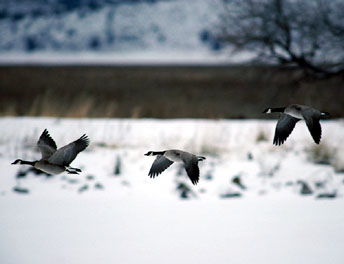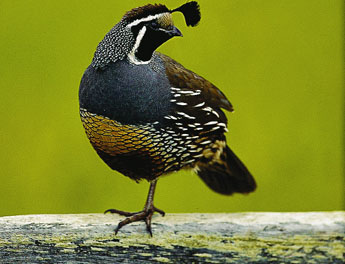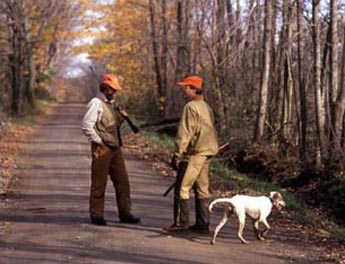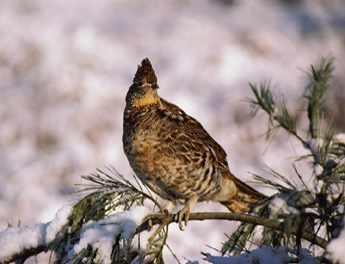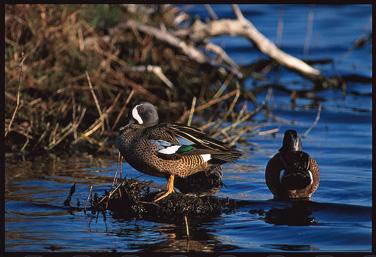While keeping an eye on the distant tree line, waiting for another flock of giant Canada geese to make its way to our decoys, I took a moment in my blind to enjoy the pond, the grassy fields and the beautiful rolling hills in front of us. Suddenly a voice came from in back of us, bringing an end to the morning hunt.
“Mind if we play through?” a surprised golfer asked. I looked on as he and his companion walked right through my rig of goose decoys. I couldn’t actually complain, since my hunting party was, in fact, the real intruder. We were hunting resident Canada geese that had taken over a very exclusive golf course just outside of Boston. I had found a club that was very happy to allow us to hunt before its members came to play, just to keep the geese off the property. You might think a golf course is an odd place to chase Canadas, but the sight of our two-person limit of 10 geese at the end of the hunt dispelled all apprehensions.
Golfers, groundskeepers and farmers alike deplore the exploding numbers of resident geese. Some blame the species’ ever-increasing population on short stopping, others on the lack of places one can hunt the cagey resident. Without question, geese have become a common sight and problem in suburban areas. Many states have opened an additional season with very generous bag limits in an attempt to keep Canada goose numbers in check. But hunting them requires entirely different tactics from what I would use for late-season migrators.
CONCEALMENT IS KEY
To be successful gunning for early-season resident geese, you have to hunt with tactics that are different from those used for migrators. With few cornfields cut, hunters should look to hayfields, sod farms or open grassy areas like golf courses. Such places attract good numbers of geese but can be a nightmare to hunt. Consistently scoring in areas where cover is non-existent requires innovative methods. To add to the difficulty, resident geese know the fields they frequent intimately. They feed in those fields every day, unlike migrators, who are happy to stop for a meal when passing through. If you set your rig improperly, chances are you’ll only witness geese flying away from your spot.
Portable laydown blinds, such as the Avery Finisher, Final Approach’s X-Land’r or Wildfowler Outfitter’s Layout Blind, allow you to get where the geese want to be. Instead of hunting the edge of the field, you can hide in the middle of the field with only the slightest of cover.
Fred Zink, one of goose hunting’s top championship callers, guides, call makers and blind innovators, has taken goose hunting and elevated it to a scientific level. He’s known for spending hours in the field just watching geese to learn their habits.
“Portable laydown blinds are comfortable and keep you concealed from even the wisest geese. Selecting a camo pattern that matches a variety of landscapes is important,” Zink advises. “I prefer the Mossy Oak Shadow Grass pattern. Its earthy tones and various colors blend into almost any situation. Another tip for camouflaging your setup is to use natural stubble from the fields. Place it into the camo straps on the blinds to create the image of a small scrap pile.”
Mobility is a major factor for consistently hunting these smart birds successfully, Zink points out. Not only does the laydown blind offer comfort and the ability to hide without digging pits, but you can easily take it apart and set up shop in another field the geese are using.
PLAYING CHESS WITH DECOYS
Decoys–and how to set them–warrant special attention as well. “By watching geese feed in the early fall, I’ve found that they tend to feed very loosely, and away from each other,” notes Zink. “Migrators, on the other hand, bunch up and compete for the sparse food left in the fields.”
“Early in the year, residents feed on grass sprouts and resprouted wheat and oats,” he continues. “This food supply is abundant and all over the field, not just in certain spots like grain fields. The most important reason that geese spread out, though, is that they still have a very strong relationship with their young. Therefore they feed in small groups of three to ten. Resident birds never want to be too close to other family groups, because that could put their young in danger of harassment by adult geese.”
When setting decoys in family groups, it’s good to have different body postures in your decoys. “I prefer looker-style full bodies to simulate adult geese alert for danger, and feeders that simulate the young-of-the-year,” says Zink. Use two to six dozen GreenHead Gear lifesize full-body decoys, just enough to break up the outline of the blinds. Place the decoys in a U-shaped spread with an opening in the middle [see sidebar].
“Remember, a goose’s instinct early in the year is not to land close to other birds, but to land near enough to use the others for protection,” says Zink. “There’s safety in numbers.”
BE AN AGGRESSIVE CALLER
Migrating geese are often wary of calling because they’ve heard it many times along their routes. But residents are quite the opposite. “With a lot of young geese in the air, strong, dominant, loud and aggressive calling is very effective. This approach will confuse most flocks early in the year and bring them in. As the season progresses, start backing off and be more conservative,” Zink says.
Calling early in the season is very easy–just concentrate on sounding like a goose and you’ll be very effective. Don’t be afraid to cluck and honk at all the flocks of geese you see, even if they’re heading to other fields. Boisterous clucks will get their attention and turn them your way.
Noted Tennessee professional waterfowl hunter Bill Cooksey agrees with many of the beliefs that Zink espouses. In addition, however, he notes that, outside of the old real-estate adage about “location, location, location,” adding movement to your decoys can be crucial for success.
“A few full-body decoys, with their legs removed and placed on motion stakes, can be deadly,” he says. “Shell decoys need to be set high off the ground, especially in areas with tall grass. Migrators will sometimes sit down to feed, but early-season residents very rarely do. Outside of that, I try to mimic what the real geese do and set up a realistic spread around my laydown blinds.”
STAY OFF THE ROOST
World goose-calling champion Shawn Stahl chases geese from September through February. His broad knowledge of these majestic birds helps him score consistently. “It’s important to begin scouting the geese in late summer to determine nighttime roosting areas, potential feeding sites and daytime resting locations,” Stahl says.
Stahl finds that geese spend less time in the fields during the hot weather of the early season. You’ll often find them under shade trees sitting down as they spend time in midday resting spots. “Ideally, you should try to obtain permission in all the sites they frequent: roost, resting spots and feeding areas. By doing this you have control over all the aspects of their daily routine,” Stahl adds.
Put the majority of your efforts into hunting the feeding fields first and last. The resting areas are best in the middle of the day. Stahl warns, however, that you should never hunt the night roosting sites.
SHOOTING A BIRDIE
Not long before the early die-hard golfers passed our decoys, a small group of geese flew in, looking for their favorite fairway. They expected to find their usual friends, and we did not disappoint them with our spread. I worked them on my short-reed call.
With a slight wind shift, the flock made its approach from behind us. If the geese continued their course, it would take them right over our heads.
“Just wait till I say to take ’em,” I whispered, between double clucks and pleading moans, to my friend in the blind next to mine.
As the flock zeroed in for a landing, another group of Canadas came over the distant trees, taking the first with them. My excitement quickly turned to fear of losing them all to a more enticing field. Hoping to bring the geese back, I started to beg and plead into the call. To make matters worse, I had noticed that one of the geese was sporting a beautiful neckband. Boy, did I want that bird! Both groups blended together near the far tree line, making for one large flock of resident geese that now had several calling judges and extra pairs of eyes to help spot anything amiss.
The birds liked what they saw and heard, and the group turned back to our spread. “Get ready. I think they’re on us now,” I cautioned, as I pulled my Benelli just a bit closer. My retriever nudged his head out from the blind, anticipating some action.
Landing gear down, cupped and committed, the flock made its way right to our rig. “Take ’em!” I called out as I flipped the lid to my blind, quickly shouldering my gun and slapping the trigger. The large gander sporting the neckband folded in slow motion. Taking delivery of the prize from my retriever, I looked at my surroundings. Surely the setting was not out of the pages of a hunting magazine or a waterfowl video, but it was satisfying nonetheless.
Fred Zink’s Decoy Set
The most successful resident goose-hunting locations for Fred Zink are in fields, preferably ones that have been freshly cut. When targeting residents, Zink prefers to set his decoy spead in a series of smaller family groups. These consist of roughly 10 clusters of two to eight birds placed in a U-shape around the laydown blinds. Fifty to sixty yards should separate the outermost huddles. The area in between serves as the landing zone. For this decoy rig Zink suggests using five dozen life-size full-body geese. Looker-style decoys should be placed at the front, back or both of each group. These “sentry” birds mimic the watchful eyes of mother geese. Set two to six active- and feeder-style decoys around the looker. It’s important to keep at least 5 yards between each family.
Shawn Stahl’s Decoy Set
Early-season geese often use cow pasture ponds as midday loafing areas. These locales provide water, grazing opportunities and, in many cases, shade trees. The majority of geese will land in the water and swim up to shore. Keep your ground blinds within 10 to 15 yards of the water’s edge. Several sentry-style decoys should be placed in or near the landing zone to represent geese that have just landed and are going to join the flock. Most often approaching geese will land in front of these confidence decoys. Adjust your landing zone and blind direction according to the wind. Also, consider the trees around the pond while setting the decoys. In most cases geese will prefer a wide-open approach to landing. Avoid setting a decoy pattern that will require geese to fly directly over the treetops in order to land. Feeding decoys should be set behind the blinds.
Pick Your Load
One topic that is guaranteed to start debates in the waterfowling community is which shotgun shells are the best. Purists long for their old lead shot, while technologically savvy hunters are constantly seeking new combinations of synthetics and metals. In the early season, though, all you need is good aim and a couple of boxes of No. 2 steel shot. Some of you might groan at this suggestion, but there’s much to consider.
During early September, geese will be gearing up for the colder weather, developing their coats of winter down. Their coats won’t be nearly as thick, however, as they will be come December. Higher shot numbers should be able to get the same amount of penetration as a BB shell. Second, loads like Federal’s Ultra-Shok and Winchester’s Drylok have consistently posted feet-per-second numbers that are as good as any other high-end synthetic on the market.
If you’re confident about your shotshell selection but are still missing geese, remember the basics of wing-shooting. Your lead on a goose in full flight should be roughly the same length as its neck.
